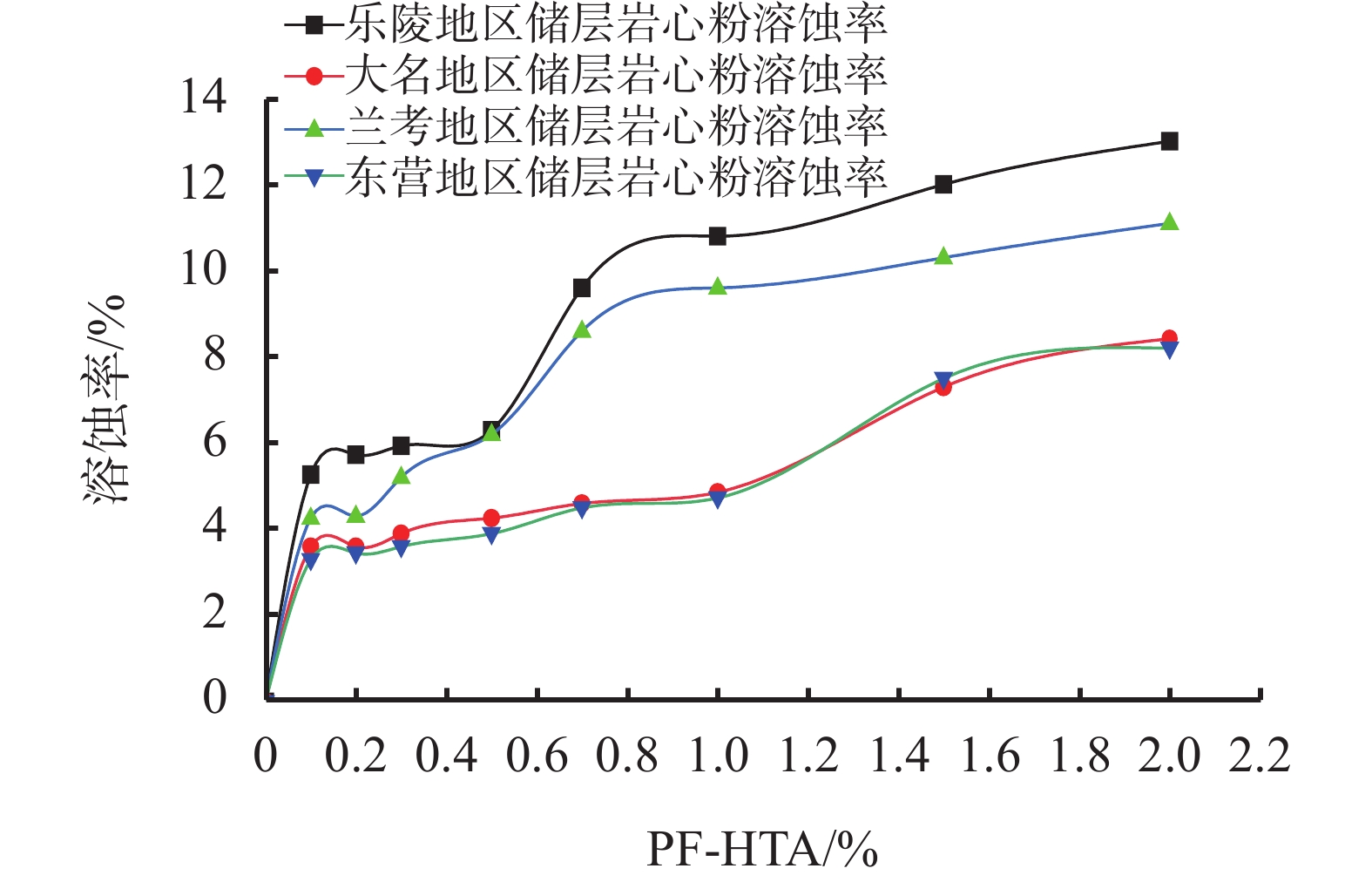Damage Preventative Completion Fluid for Sandstone Geothermal Reservoir
-
摘要: 我国地热资源开发利用正处于快速发展阶段,以中低温的砂岩热储层地热资源开发利用为主。然而在开发地热资源时,由于疏松的砂岩热储层特殊的地质构造,在钻完井的过程中,储层出砂严重同时钻完井液容易进入储层造成敏感性伤害以及钻完井液中固体物质堵塞储层引起储层渗透下降的问题。针对上述问题,本研究引入了关键处理剂仿生固壁剂、隐形酸PF-HTA、缓蚀剂并通过实验进行了加量的优选,最终形成了聚膜隐形酸完井液体系。室内研究表明该完井液体系污染储层岩心后渗透率恢复值大,与钻井液配伍性良好,对储层损伤小,具有良好的储层保护效果。Abstract: The development and utilization of geothermal resources in China is at a rapid stage of development, with the development and utilization of geothermal resources in sandstone thermal reservoirs of medium and low temperatures as the main. However, during the development of geothermal resources, due to the special geological structure of loose sandstone thermal reservoir, during the drilling and completion process, the reservoir sand production is serious, and the drilling and completion fluid is easy to enter the reservoir to cause sensitivity damage, as well as the problem that the solid substances in the drilling and completion fluid block the reservoir and cause the reservoir permeability to drop. In order to solve the above problems, this study introduced the key treatment agents, such as bionic wall fixative, stealth acid PF-HTA and corrosion inhibitor, and optimized the dosage through experiments. Finally, the polymer film stealth acid completion fluid system was formed. Laboratory research shows that the completion fluid system has a large permeability recovery value after polluting the reservoir core, good compatibility with drilling fluid, little damage to the reservoir, and good reservoir protection effect.
-
Key words:
- Sandstone thermal reservoir /
- Permeability /
- Completion fluid
-
表 1 完井液配伍性评价实验
浊度/UTN
工作液混合比例(V/V) 现象 9∶1 5∶5 1∶9 乐陵地区钻井液∶完井液 423 288 156 无沉淀 兰考地区钻井液∶完井液 620 618 389 无沉淀 大名地区钻井液∶完井液 448 315 125 无沉淀 东营地区钻井液∶完井液 453 204 210 无沉淀 表 2 聚膜隐形酸完井液保护效果
储层岩心地区 长度/cm 直径/cm T/℃ 孔隙度/% K0/mD Kd/mD Kd/K0/% 乐陵 9.5 2.5 75 24.88 34.98 36.210 103.82 大名 9.7 2.4 55 9.70 34.58 36.403 105.27 兰考 9.4 2.4 76 45.27 13.34 15.680 117.54 东营 8.5 2.4 60 31.47 159.50 159.980 100.30 -
[1] 颜世强,刘桂仪,孟庆峰,等. 德州市地热资源及开发利用[J]. 山东地质,2001(2):48-52.YAN Shiqiang, LIU Guiyi, MENG Qingfeng, et al. Geothermal resource characteristics and its exploitation future in Dezhou city[J]. Geology of Shandong, 2001(2):48-52. [2] 肖雄,李尧,杨珍,等. 河南省兰考县新生界地热资源特征及开发利用前景[J]. 地下水,2022,44(2):72-74, 110. doi: 10.19807/j.cnki.DXS.2022-02-023XIAO Xiong, LI Yao, YANG Zhen, et al. Characteristics and prospect of geothermal resources in Lankao county Henan province[J]. Ground Water, 2022, 44(2):72-74, 110. doi: 10.19807/j.cnki.DXS.2022-02-023 [3] 景成虎. 邯郸东部平原地区地热地质特征及开发利用研究[D]. 北京: 中国地质大学(北京), 2007.JING Chenghu. Research on geothermal geological characteristics and development and utilization in the eastern plain of Handan [D]. Beijing: China University of Geosciences (Beijing), 2007. [4] 陈建宏. 渤中34-9油田定向井完井液优选研究[J]. 石油化工应用,2021,40(1):104-107. doi: 10.3969/j.issn.1673-5285.2021.01.023CHEN Jianhong. Optimization of completion fluid system for Bozhong 34-9 oilfield directional well[J]. Petrochemical Industry Application, 2021, 40(1):104-107. doi: 10.3969/j.issn.1673-5285.2021.01.023 [5] 岳前升,向兴金,王昌军,等. 隐形酸完井液及其在王44区块中的应用[J]. 河南石油,2005(1):49-50,53.YUE Qiansheng, XIANG Xingjin, WANG Changjun, et al. Chelating acid completion fluid and its application in Wang 44 block[J]. Henan Petroleum, 2005(1):49-50,53. [6] 赖燕玲,向兴金,王昌军,等. 隐形酸完井液效果评价及应用[J]. 石油天然气学报,2011,33(3):115-119, 168.LAI Yanling, XIANG Xingjin, WANG Changjun,et al. Evaluation and application of invisible acid completion fluid[J]. Journal of Oil and Gas Technology, 2011, 33(3):115-119, 168. [7] 宣扬,蒋官澄,李颖颖,等. 基于仿生技术的强固壁型钻井液体系[J]. 石油勘探与开发,2013,40(4):497-501. doi: 10.11698/PED.2013.04.17XUAN Yang, JIANG Guancheng, LI Yingying, et al. A biomimetic drilling fluid for wellbore strengthening[J]. Petroleum Exploration and Development, 2013, 40(4):497-501. doi: 10.11698/PED.2013.04.17 [8] 徐桂英,李淑华. CA型缓蚀剂对碳钢的缓蚀作用的研究与应用[C]//. 第十届全国缓蚀剂学术讨论会论文集. 1997: 144-147.XU Guiying, LI Shuhua. Research and application of CA type corrosion inhibitor on corrosion inhibition of carbon steel [C]//. Proceedings of the 10th National Symposium on Corrosion Inhibitors. 1997: 144-147. [9] 范鑫. 缓蚀剂在油气井生产中的应用研究进展[J]. 山东化工,2022,51(4):100-102. doi: 10.19319/j.cnki.issn.1008-021x.2022.04.012FAN Xin. Advances in the application of corrosion inhibitor in oil and gas well production[J]. Shandong Chemical Industry, 2022, 51(4):100-102. doi: 10.19319/j.cnki.issn.1008-021x.2022.04.012 [10] 刘万岭. 苏里格气田裂缝性致密砂岩储层保护技术研究[D]. 中国石油大学(华东), 2019.LIU Wanling. Research on protection technology of fractured tight sandstone reservoir in Sulige gas field [D]. China University of Petroleum (East China), 2019. [11] 张朔,蒋官澄,郭海涛,等. 新型钻井液成膜剂的研制及其在埕海油田的应用[J]. 石油钻探技术,2013,41(2):44-48. doi: 10.3969/j.issn.1001-0890.2013.02.009ZHANG Shuo, JIANG Guancheng, GUO Haitao, et al. Development of new film-forming agent for drilling fluids and application in Chenghai Oilfield[J]. Petroleum Drilling Techniques, 2013, 41(2):44-48. doi: 10.3969/j.issn.1001-0890.2013.02.009 [12] 张麒麟,龚保强,鄢捷年,等. 中原油田特殊工艺井钻井液的研究与应用[J]. 钻井液与完井液,2005,22(4):12-15. doi: 10.3969/j.issn.1001-5620.2005.04.004ZHANG Qilin, GONG Baoqiang, YAN Jienian, et al. Drilling fluids for special wells in Zhongyuan oilfield[J]. Drilling Fluid & Completion Fluid, 2005, 22(4):12-15. doi: 10.3969/j.issn.1001-5620.2005.04.004 [13] WANG Rui. A laboratory approach to predict the water-based drill-in fluid damage on a shale formation[J]. Energy Exploration & Exploitation, 2020, 38(6):014459872093751. [14] ABDOLREZA DABIRI, MOHAMMAD AFKHAMI, HOOMAN FALLAH. Reservoir formation damage due to mud filtration[J]. American Journal of Chemical Engineering, 2013, 1(1):1-1. [15] SU Zhenguo, LIU Junyi, WANG Ruihe, et al. Experimental study of novel reservoir protection agents for low permeability reservoirs in water-based drilling fluids[J]. Chemical Engineering Transactions (CET Journal) , 2018, 66. [16] 段友智,侯倩,刘锦春,等. 完井用多孔隙形状记忆聚合物的性能影响因素研究[J]. 石油钻探技术,2021,49(2):67-71.DUAN Youzhi, HOU Qian, LIU Jinchun, et al. Study on the influencing factors of the properties of porous shape memory polymer for well completion[J]. Petroleum Drilling Techniques, 2021, 49(2):67-71. -





 下载:
下载:








